Department of Animal Nutrition

Head of the Department
Barbara Kowalik, PhD, DSc, institute professor
🖂 b.kowalik@ifzz.pl
Researches
Prof. PhD DSc. Marian Czauderna, 🖂 m.czauderna@ifzz.pl
PhD DSc. Grzegorz Bełżecki, 🖂 g.belzecki@ifzz.pl
PhD DSc eng. Małgorzata Białek, institute professor, 🖂 m.bialek@ifzz.pl
PhD DSc eng. Paweł Konieczka, prof. UWM, 🖂 p.konieczka@ifzz.pl
PhD DSc Paweł Kowalczyk, 🖂 p.kowalczyk@ifzz.pl
PhD DSc Renata Miltko, institute professor, 🖂 r.miltko@ifzz.pl
PhD DSc Grzegorz Skiba, institute professor, 🖂 g.skiba@ifzz.pl
PhD DSc Ewa Święch, institute professor, 🖂 e.swiech@ifzz.pl
PhD DSc Anna Tuśnio, institute professor, 🖂 a.tusnio@ifzz.pl
PhD eng. Marcin Barszcz, 🖂 m.barszcz@ifzz.pl
PhD Małgorzata Majewska, 🖂 m.majewska@ifzz.pl
PhD eng. Monika Sobol, 🖂 m.sobol@ifzz.pl
MSc Kamil Gawin, 🖂 k.gawin@ifzz.pl
MSc Misza Kinsner, 🖂 m.kinsner@ifzz.pl
MSc Adrianna Konopka, 🖂 a.konopka@ifzz.pl
MSc Wiktoria Wojtak, 🖂 w.wojtak@ifzz.pl
Scientific and Engineering Staff
PhD DSc Agnieszka Białek 🖂 a.bialek@ifzz.pl
Engineering Staff
Eng. Natalia Frączek, 🖂 n.fraczek@ifzz.pl
MSc Aneta Kędzierska, 🖂 a.kedzierska@ifzz.pl
MSc eng. Urszula Wolska-Świętlicka, 🖂 u.wolska-swietlicka@ifzz.pl
Technical Staff
Malwina Krakowiak, 🖂 m.krakowiak@ifzz.pl
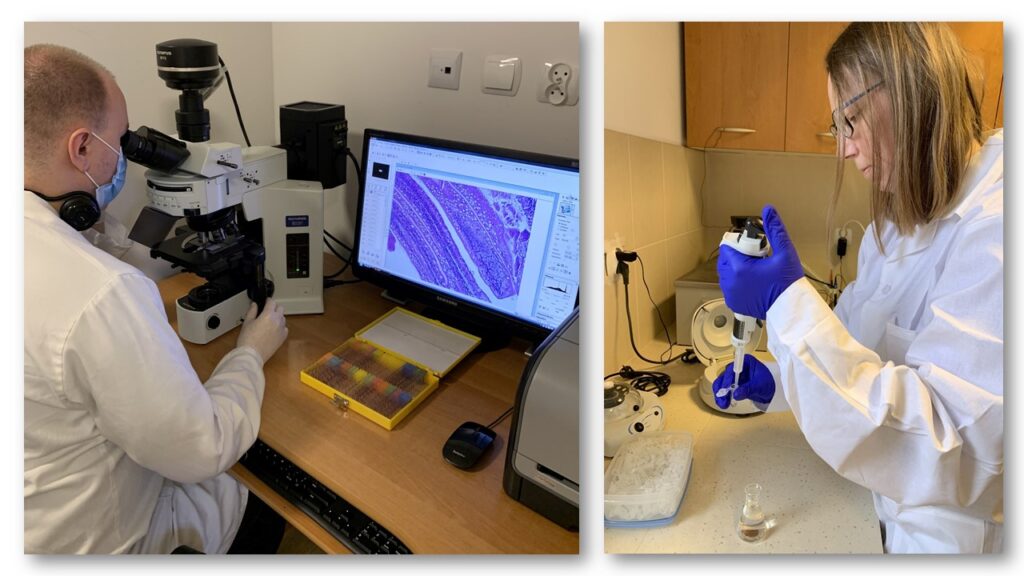
Current research topics
- Identification and characterisation of microorganisms present in fermentative chambers of digestive tract in mammals.
- Isolation and cultivation of microorganisms in vitro.
- Description of qualitative and quantitative changes of symbiotic rumen microflora and microfauna under bioactive feed constituents.
- Participation of rumen ciliates in methanogenesis and lipid metabolism.
- Isolation and characterisation of microbiological enzymes catalysing the digestion of carbs and structural carbohydrates (of plant and microbiological origin) in the rumen.
- Influence of feed ingredients on digestion processes in the rumen and in the small intestine, production and meat quality.
- Feed digestion in the rumen in sacco.
- Improving and developing methods of designating contents of selected feed constituents and measurements of protein synthesis in the microorganisms present in the rumen.
- Description of large intestine microflora in monogastric animals.
- Domestic protein sources in piglet and chicken feeding.
- Diet and oxidative stress in piglet and chicken.
- Influence of technological processes on nutritional value of legumes in the studies on chicken and piglets.
- Influence of bioactive substances on the immune system of gastrointestinal tract in monogastric animals.
- In vitro methods in the studies on nutritional components digestion and microflora activity.
- Studies on influence of fibre on gastrointestinal tract physiology.
- Influence of feeding factors on pig growth and welfare and quality of products.
- The quality of animal products depending on feeding and endogenous factors.
- Physiological role of CLA isomers in programming babies health via feeding mothers suffering from cancer (rat model).
- Influence of oil and antioxidants on fatty acid and amino acid profiles, anti-oxidative status and cholesterol in selected animal tissues.
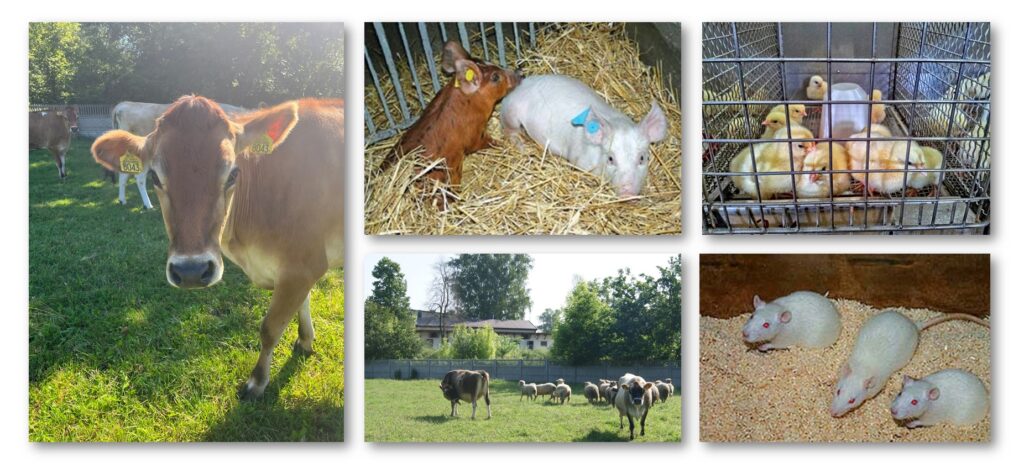
Main achievements
- Identification and characterisation of new bacteria species Treponema zioleckii and settlement of method describing bacteria biomass on the basis of mureine content (Piknova et al., 2008. FEMS Microbiol. Lett. 289, 166-172; Bełżecki et al., 2012. J. Anim Feed Sci. 21, 624-634).
- It was revealed that rumen ciliates can be used as potential hydrogen source in the fuel cell used to acquire electrical energy and that they are equipped with enzymes that can putrefact carbohydrates, including chitin (Piela et al., 2010. J. Microbiol. Biotechnol. 20, 1092-1100; Miltko et al., 2015. J. Anim. Feed Sci. 24, 203-207; Miltko et al., 2016. Arch. Anim. Nutr. 70, 425-440).
- It was noted that the addition of oak bark (Quercus) to sheep diets improved the number of rumen microorganisms and stimulated the exocrine activity of pancreas. Also, it was revealed that addition of lingonberry leaves (Vaccinium vitis idaea L.) to lamb diet improved the meat quality (Majewska et al., 2021. Anim. Biosci. 34, 1146-1156, Majewska et al., 2017. J. Anim. Feed Sci. 26, 354-358; Majewska and Kowalik, 2020. Eur. J. Lipid Sci. Tech. 122, 1900273).
- The addition of plant oils with the high amount of α-linolenic (linseed oil) and oleic (rapeseed oil) acids to sheep diets reduces the cellulose dispersion. Also, it was revealed that rapeseed oil negatively influences the pectinolic enzymes activity in the sheep rumen. What is more, it was observed that above mentioned oils increase the activity of pancreas lipase, and that linseed oil increases the quality of lamb meat more than rapeseed oil (Majewska et al., 2020. Livest. Sci. 240, 104175; Kowalik et al., 2018. J. Anim. Physiol. Anim. Nutr. 102, 1194-1198; Miltko et al., 2019. Asian-Austral. J. Anim. Sci. 32, 767-775).
- It was noted that carnosic acid and selenate added to the diet decrease the CH4 and CO2 emissions in the sheep rumen and improve the feed conversion efficiency in lambs. Also, it was observed that selenate decreases biohydrogenation of unsaturated amino acids in the sheep rumen (Białek et al., 2019. Livest. Sci. 226, 122-132; Miltko et al., 2016. Acta Vet.-Beograd 66, 373-391; Białek et al., 2020. Livest. Sci. 241, 104249).
- The addition of fish oil with organic selenium and carnosic acid to lamb diet increases the density and improves the biomechanical properties of lamb bones (Skiba et al., 2021. Animals 11, 230).
- Inulin-type fructans can contribute to piglets welfare improvement by increasing Bifidobacterium population, antioxidative activity and positive changes in protein expression in pig large intestine mucosa. So, positive influence on intestinal barrier functioning, protection from endotoxins and free radicals, and also possibility of inulin usage in diet prevention for large intestine diseases (Barszcz et al., 2016. Anim. Nutr. 70, 278-292; Barszcz et al., 2018. Anim. Prod. Sci. 58, 1109-1118; Herosimczyk et al., 2020. Animal 14, 1647-1658).
- It was revealed that zinc glycinate addition to piglet diet improves the Clostridium herbivorans population and the addition of potato fibre improves the activity of bacterial β-glycosidase in the large intestine, which results in the increased dietary fibre digestibility (Barszcz et al., 2019. Livest. Sci. 227, 37-43; Barszcz et al. 2021. Livest. Sci. 245, 104429).
- The high amounts of narrow-leaved lupin (Lupinus angustifolius) in the diet, and micronization process can negatively affect the content and activity of large intestine microflora in piglets. Also, it was noted that high amount of lupin in the diet can negatively affect the piglet weight gain (Tuśnio et al., 2020. Livest. Sci. 240, 104137).
- The interactions between protein and carbohydrates source in the diet influence the pig large intestine bacterial flora activity. The modification of proteolytic fermentation with the use of complex carbohydrates is possible, however the direction of such changes is dependent on the carbohydrates type. Raw potato starch intensifies the negative influence of the worse digested protein in the small intestine, and cellulose and pectin reduce the intensity of bacterial proteolysis (Taciak et al., 2017. Arch. Anim. Nutr. 7, 192-209).
- The supplementation of inulin to the diet reduces the negative influence of high-fat diet rich in saturated fatty acids on bone health in growing pigs and health-promoting and technological properties of pork meat, and also dependence of n-6/n-3 PUFA in the diet and body and growing piglets bone properties were estimated (Sobol et al., 2018. Br. J. Nutr. 119: 1111-1118; Przybylski et al., 2019. J. Anim. Physiol. Anim. Nutr. 103, 593-602; Sobol et al., 2019. Br. J. Nutr. 121, 508–518).
- It was observed that low proportion of dietary n-6/n-3 PUFA and increased vitamin E level in chicken diet negatively influence DNA damage in intestinal epithelial cells, and gut morphology. Also increasing level of vitamin E in breeding diets results resistance to the activity of acetylsalicylic acid in broiler chickens with induced inflammation. Made for the first time on poultry the analysis of oxygen consumption by blood platelets mitochondria revealed that acetylsalicylic acid does not negatively influence the mitochondria functioning, and quite the contrary, can counteract negative results of inflammation (Konieczka et al., 2018. Poult. Sci. J. 97, 149-158; Konieczka et al., 2019. Vet. Res. 50, ID 65).
- It was revealed that nano selenium (Nano-Se) and the Cannabis sativa extract in broiler chicken nutrition can assist the functioning of intestinal barrier in birds prone to bacteria perfringens infection responsible for necrotizing enterocolitis in poultry (Konieczka et al., 2020. Vet. Res. 51, ID 141).
- CLA isomers in the diets of rats with induced mammary gland cancer suppress peroxidation of polyunsaturated fatty acids and reduce the level of aterogenic saturated fatty acids and cholesterol oxidation (Białek et al., 2019, Nutrients 11, 2032; Białek et al., 2020, Animals 10, 464).
- Pomegranate seed oil was found to influence the fatty acids profile and content, to decrease the activity of desaturases and to hold down creating the products of lipid oxidation in livers of rats (Białek et al., 2017. Prostagland. Other Lipid Mediat. 131, 9-16).
- Coumarin derivatives, 1.2 alfa-aminoamdes, diaryloetanols and δ-lactons, toxically affect bacterial cells of coliK12, R1-R4 in the gastrointestinal tract. Such compounds induce oxidative stress in pathogenic bacteria cells and suppress their replication. It was also revealed that these derivatives act more effectively and selectively to certain E. coli strains, at the same time are more biologically stable and more toxic for humans than traditionally used antibiotics (Kowalczyk et al., 2020. Materials 13, 2499; Kowalczyk et al., 2020. Materials 13, 5169; Kowalczyk et al., 2021. Materials 14, 1025; Kowalczyk et al., 2021. Materials 14, 2956).
Selected publications
- Barszcz M., Tuśnio A., Taciak M., 2024. Poultry nutrition. Physical Sciences Reviews. 9, 2, 611-650, https://doi.org/10.1515/psr-2021-0122
MNiSW 20 pkt. - Bełdowska A., Pietrzak E., Biesek J., Barszcz M., Tuśnio A., Konopka A., Gawin K., Dunisławska A. 2024. The effect of sodium butyrate administered in ovo on the health status and intestinal response in broiler chicken. Poultry Science 103, 104108, https://doi.org/10.1016/j.psj.2024.104108
MNiSW 140 pkt. IF 3,8 Q1 - Bełdowska A., Siwek M., Biesek J., Barszcz M., Tuśnio A., Gawin K., Dunisławska A. 2024. Impact of in ovo administration of xylo- and mannooligosaccharides on broiler chicken gut health. Poultry Science 103, 104261, https://doi.org/10.1016/j.psj.2024.104261 MNiSW 140 pkt. IF 3,8 Q1
- Białek M., Białek A., Wojtak W., Czauderna M. 2024. Organic and inorganic selenium compounds affected lipidomic profile of spleen of lambs fed with diets enriched in carnosic acid and fish oil. Animals14, 1, 133, https://doi.org/10.3390/ani14010133 MNiSW 100 pkt. IF 3,0 Q1
- Białek M., Lepionka T., Wojtak W., Ruszczyńska A., Bulska E., Czauderna M. and Białek A., 2024. Splenic elemental composition of breast cancer-suffering rats supplemented with pomegranate seed oil and bitter melon extract. Molecules29, 1942, https://doi.org/10.3390molecules29091942 MNiSW 140 pkt. IF 4,2 Q1
- Bień D., Michalczuk M., Jóźwik A., Matuszewski A. Konieczka P. 2024. Effects of cannabis sativa extract on growth performance, meat physicochemical properties, and oxidative status in chickens challenged with Clostridium perfringens and lipopolysaccharide. Animal Science Papers and Reports 42, 1: 81-108, https://doi.org/10.2478/aspr-2023-0024 MNiSW 100 pkt. IF 0,9 Q3
- Chodkowska K.A., Barszcz M., Tuśnio A. 2024. MicroRNA expression and oxidative stress markers in pectoral muscle of broiler chickens fed diets supplemented with phytobiotics composition. Scientific Reports14, 4413, https://doi.org/10.1038/s41598-024-54915-y MNiSW 140 pkt. IF 3,8 Q1
- Czauderna M., Taubner T., Wojtak W. 2024. Comparative study of gas and liquid chromatography methods for the determination of underivatised neutral and acidic cannabinoids and cholesterol. Molecules 29, 2165, https://doi.org/10.3390/molec ules29102165 MNiSW 140 pkt. IF 4,2 Q1
- Czauderna M., Wojtak W., Białek M., Białek A. 2024. Optimization of high-efficient pre-column sample treatments and C18-UFLC method for selective quantification of selected chemical forms of tocopherol and tocotrienol in diverse foods. Food Chemistry, 437, 137909, https://doi.org/10.1016/j.foodchem.2023.137909; MNiSW 200 pkt. IF 8,8 Q1
- Czerwonka M., Białek A., Bobrowska-Korczak B. 2024. A novel method for the determination of squalene, cholesterol and their oxidation products in food of animal origin by GC-TOF/MS. International Journal of Molecular Sciences. 25 (5), 2807, https://doi.org/10.3390/ijms25052807
MNiSW 140 pkt. IF 4,9 Q1 - Czerwonka M., Białek A., Skrajnowska D., Bobrowska-Korczak B. 2024. Evaluation and discrimination of lipid components and iron and zinc levels in chicken and quail eggs available on the Polish market. Foods. 13, 10, 1571, https://doi.org/10.3390/foods13101571 MNiSW 100 pkt. IF 4,7 Q1
- Czerwonka M., Gielecińska A., Białek A., Białek M., Bobrowska-Korczak B., 2024. Cholesterol and Its oxidation derivatives content in market dairy products. Nutrients 16, 1371, https://doi.org/10.3390/nu16091371 MNiSW 140 pkt. IF 4,8 Q1
- Ferenc K., Marcinkowski M., Olszewski J., Kowalczyk P., Pilžys T., Garbicz D., Dib N., Świderska B., Matyba P., Gajewski Z., Grzesiuk E., Zabielski R. 2024.
The proteomic profile is altered but not repaired after bariatric surgery in type 2 diabetes pigs. Scientific Reports 14, 10235. https://doi.org/10.1038/s41598-024-60022-9 MNiSW 140 pkt.. IF 3,8 Q1 - Głogowski R., Clauss M., Bełżecki G. 2024. Biochemical properties and hydrolytic activity in the nutria (Myocastor coypus) digestive tract. Animal Science and Genetics 20, 1, 3-10. https://doi.org/10.5604/01.3001.0054.3912 MNiSW 70 pkt; IF= 1,8; Q3
- Jelińska M., Białek A., Czerwonka M., Skrajnowska D., Stawarska A., Bobrowska-Korczak B. 2024. Knowledge of Food–Drug Interactions among Medical University Students. Nutrients 16, 15, 2425, https://doi.org/10.3390/nu16152425 MNiSW 140 pkt. IF 4,8 Q1
- Jęczmyk A., Krych S., Jekiełek M., Jurkiewicz M., Kowalczyk P., Kramkowski K., Hrapkowicz T. 2024. Wound healing complications after sternotomy-causes, prevention, and treatment-a new look at an old problem. Journal of Clinical Medicine. 13, 7431, https://doi.org/10.3390/jcm13237431 MNiSW 140 pkt. IF 3,0 Q1
- Johne M., Maculewicz E., Mastalerz A., Białek M., Wojtak W., Osuch B., Majewska M., Czauderna M., Białek A. 2024. Dietary Patterns, Serum BDNF and Fatty Acid Profiles in Physically Active Male Young Adults: A Cluster Analysis Study. Nutrients. 16(24), 4326, https://doi.org/10.3390/nu16244326 MNiSW 140 pkt. IF 4,8 Q1
- Konieczka P., Przybylski W., Jaworska D., Żelechowska E., Sałek .P, Szkopek D., Drażbo A., Kozłowski K., Jankowski J. 2024. Myofibrillar protein profile of the breast muscle in turkeys as a response to the variable ratio of limiting amino acids in feed. Agriculture 14, 2, 197, https://doi.org/10.3390/agriculture14020197 MNiSW 100 pkt. IF 3,3 Q1
- Konopka A., Gawin K., Barszcz M. 2024. Hedgehog signalling pathway and its role in shaping the architecture of intestinal epithelium. International Journal of Molecular Sciences. 25, 12007, https://doi.org/10.3390/ijms252212007 MNiSW 140 pkt. IF 4,9 Q1
- Kowalczyk P., Krych S., Kramkowski K., Jęczmyk A., Hrapkowicz T. 2024. Effect of oxidative stress on mitochondrial damage and repair in heart disease and ischemic events. International Journal of Molecular Sciences. 25, 12467, https://doi.org/10.3390/ijms252212467 MNiSW 140 pkt. IF 5,6 Q1
- Krych S., Jęczmyk A., Jurkiewicz M., Żurek M., Jekiełek M., Kowalczyk P., Kramkowski K., Hrapkowicz T. 2024. Viral Myocarditis as a Factor Leading to the Development of Heart Failure Symptoms, Including the Role of Parvovirus B19 Infection—Systematic Review. International Journal of Molecular Sciences 25, 8127, https://doi.org/10.3390/ijms25158127 MNiSW 140 pkt. IF 5,6 Q1
- Lauková A., Chrastinová Ľ., Focková V., Plachá I., Bino E., Grešáková Ľ., Formelová Z., Žitňan R., Belzecki G., Miltko R., Pogány Simonová M. 2024. Assessment of postbiotic, mundticin-like substance EM 41/3 application in broiler rabbits. Applied Sciences 14, 12, 5059, https://doi.org/10.3390/app14125059 MNiSW 100 pkt. IF 2,5 Q3
- Lauková A., Chrastinová L., Plachá I., Focková V., Zábolyová N., Bino E., Grešáková L., Žitňan R., Formelová Z., Ščerbová J., Belzecki G., Miltko R., Pogány Simonová M. 2024. Dairy-derived and bacteriocin-producing strain Lactiplantibacillus plantarum LP17L/1: An assessment of Its safety and effect using broiler rabbits. Frontiers in Bioscience – Elite16, 3, 21, https://doi.org/10.31083/j.fbe1603021 MNiSW 70 pkt. IF 0
- Lepionka T., Białek M., Czauderna M., Wojtak W., Maculewicz E., Białek A. 2024. Exploring the influence of the selected conjugated fatty acids isomers and cancerous process on the fatty acids profile of spleen. Cancers 16, 3, 479, https://doi.org/10.3390/cancers16030479 MNiSW 140 pkt. IF 4,5 Q1
- Majewska M.P., Wolska-Świętlicka U., Miltko R., Bełżecki G., Kędzierska A., Kowalik B. 2024. The effect of natural and synthetic zeolites on polysaccharidase activity in the rumen of Jersey heifers. Journal of Animal and Feed Sciences 33, 4, 535-541, https://doi.org/10.22358/jafs/194302/2024 MNiSW 100 pkt. IF 1,4 Q3
- Miltko R., Majewska M.P., Frączek N., Kowalik B., 2024. Evaluation of the biochemical composition of the greater duckweed Spirodela polyrhiza (L. Schleiden). Journal of Animal and Feed Sciences 33, 4, 542-546, https://doi.org/10.22358/jafs/193033/2024 MNiSW 100 pkt. IF 1,4 Q3
- Miltko R., Majewska M.P., Wojtak W., Białek M., Kowalik B., Czauderna M. 2024. Comparing the chemical composition of lesser duckweed (Lemna minor L.) grown in natural and laboratory settings. Journal of Animal and Feed Sciences 33, 3, 357-367, https://doi.org/10.22358/jafs/189963/2024 MNiSW 100 pkt. IF 1,4 Q3
- Paslawski R., Kowalczyk P., Paslawska U., Wiśniewski J., Dzięgiel P., Janiszewski A., Kiczak L., Zacharski M., Gawdzik B., Kramkowski K., Szuba A. 2024. Analysis of the model of atherosclerosis formation in pig hearts as a result of impaired activity of DNA repair enzymes. International Journal of Molecular Sciences 25, 4, 2282, https://doi.org/10.3390/ijms25042282 MNiSW 140 pkt. IF 5,6 Q1
- Sobol M., Skiba G., Kowalczyk P., Świątkiewicz M., Grela E.R. 2024. Markers of bone turnover and biomechanical properties of the third metacarpal bone of growing pigs subjectet to the different dietary phosphorus and calcium content. Annals of Animal Science 24, 2, 479–490 https://doi.org/10.2478/aoas-2024-0010 140 pkt. IF 1,8 Q2
- Szkopek D., Mendel M., Kinsner M., Fotschki B., Juśkiewicz J., Kozłowski K., Matusevičius P., Konieczka P. 2024. Interaction Between Peroxisome Proliferator-Activated Receptors and Cannabidiol in the Gut of Chickens Applied to Different Challenge Conditions. International Journal of Molecular Sciences25, 21, 11398, https://doi.org/10.3390/ijms252111398 MNiSW 140 pkt 4,9 Q1
- Szkopek D., Pierzynowski S.G., Pierzynowska K., Zaworski K., Kondej A Pancreatic., Wychowański P., Konieczka P., Seklecka B., Donaldson J., Jank M., Woliński J. 2024. A review: enzymes in the treatment of chronic pancreatic insufficiency in companion animals. Journal of Veterinary Internal Medicine 38, 2, 2026-2033, https://doi.org/10.1111/jvim.17096 MNiSW 200 pkt. IF 2,1 Q1
- Świątkiewicz M., Szczepanik K., Gala Ł., Grela E.R., Witaszek K., Barszcz M., Tuśnio A., Taciak M. 2024. Determination of the impact of extruded soybean press cake on rearing and health indices of piglets. Agriculture. 14, 1899, https://doi.org/10.3390/agriculture14111899 MNiSW 100 pkt. IF 3,3 Q1
- Święch E. 2024. Effect of dietary wheat gluten levels on intestinal mucin flow and composition in young pigs.Journal of Animal and Feed Sciences 33, 517-524, https://doi.org/10.22358/jafs/189648/2024 MNiSW 100 pkt. IF 1,4; Q3
- Wavhal D.S., Koszelewski , Gulko C., Kowalczyk P., Brodzka A., Kramkowski K., Ostaszewski R. 2024. Mystery of the Passerini Reaction for the Synthesis of the Antimicrobial Peptidomimetics against Nosocomial Pathogenic Bacteria. International Journal of Molecular Sciences25, 15, 8330, https://doi.org/10.3390/ijms25158330 MNiSW 140 pkt. IF 4,9 Q1
- Wojtak W., Białek M., Białek A., Molik E., Czauderna M. 2024. Content of orotic acid and selected bioactive compounds in ovine milk during lamb rearing. Journal of Animal and Feed Sciences 33, 547-561, https://doi.org/10.22358/jafs/188489/2024 MNiSW 100 pkt. IF 1,4 Q3
- Wójcik M., Zieba D.A., Bochenek J., Krawczyńska A., Barszcz M., Gajewska A., Antushevich H., Herman A.P. 2024. The Effect of Endotoxin-Induced Inflammation on the Activity of the Somatotropic Axis in Sheep. International Journal of Inflammation 1057299, https://doi.org/10.1155/2024/1057299 MNiSW 140 pkt. IF 2,6 Q3
- Wypych A., Lepczyński A., Ożgo M., Bernaciak M., Herosimczyk A., Barszcz M., Gawin K., Ciechanowicz A.K., Kucia M., Pierzchała M. 2024. Effect of feeding high fat diets differing in fatty acid composition on oxidative stress markers and protein expression in mouse kidney. Journal of Animal and Feed Sciences 33, 2, 170-184, https://doi.org/10.22358/jafs/175920/2024 MNiSW 100 pkt. IF 1,4 Q3
Laboratory of Analysis of Gastrointestinal Tract Protective Barrier


Head of the Laboratory
PhD eng. Marcin Barszcz
🖂 m.barszcz@ifzz.pl
Laboratory of Analysis of Gastrointestinal Tract Protective Barrier is a new organisational unit of Department of Animal Nutrition established in 2018 through the funding of Ministry of Science and Higher Education within a framework of an application for a financial support of Institute’s restructuring in 2018-2019.
Research topics:
- The Laboratory performs studies on the gut immune system of livestock and laboratory animals.
- The aim of research is to determine the effect of nutrition (diet, nutrients, bioactive compounds) on the innate and active immunity of the gut and microbiota role in barrier function shaping.
- The Laboratory analyses biological material (tissues, body fluids etc.) on order and is open for a cooperation with local and foreign scientific units and other subjects.
Offer:
- The Laboratory has at its disposal a wide range of analytical methods enabling determining the parameters specific for gastrointestinal tract protective barrier and immune system functioning.
- The equipment also enables performing analyses not related to the Laboratory’s specificity.
- For preparation of biological material for studies and in most analyses performed in the Laboratory other equipment of Department of Animal Nutrition is used.
Sample type:
- Animal tissues, homogenates, supernatants
- Cell suspensions
- Body fluids
- Depending on the analysis the laboratory accepts fresh or frozen samples
Analyses
Flow cytometer BD FACSCelesta:
- subpopulation of immune cells (isolated from the gastrointestinal tract and blood)
- granulocyte and monocte functions:
− phagocytosis
− oxidative burst
− others
Spectrofluorimeter SpectraMax iD3:
- mucin concentration:
- concentration of secretory immunoglobulin A, other antibodies and proteins (ELISA)
- activity of antioxidant enzymes
- other microplate analyses based on absorbance, fluorescence and luminescence measurements
Cell counter Arthur:
- cell count in suspension (standardisation for flow cytometry and other analyses)
- cell viability (propidium iodide method)
- cell cycle (propidium iodide method)
- apoptosis (annexin V and propidium iodide method)
- green fluorescence protein (GFP) expression
- red fluorescence protein (RFP) expression
MIC qPCR thermocycler
- expression of genes coding, e.g. mucin, cytokines, transporting proteins, microRNA
Histological analysis
- tissue processing and embedding in paraffin blocks
- cutting of biological materials embedded in paraffin blocks (rotary microtome HM355S)
- histological staining:
− haematoxylin-eosin (HE)
− phloxin-tartrazine (PT)
− alcian blue-periodic acid-Schiff reagent (AB-PAS)
− toluidine blue (TB)
- microscopic examination
− intraepithelial lymphocyte count in the small and large intestine of pigs (HE)
− mast cell count (TB)
− goblet cell type and count (AB-PAS)
− Paneth cell count in the small intestine of laboratory rodents (PT).
The Laboratory’s offer will be extended soon by other analytical methods, which are being developed currently.
Equipment

Seahorse XF Pro analyzer
The Seahorse XF Pro (Agilent Technologies, Inc., Lexington, MA, USA) is a real-time cellular metabolism analyzer that enables automatic, simultaneous measurement of two major metabolic pathways responsible for energy production in cells: glycolysis and mitochondrial respiration. Measurements of oxygen consumption rate and degree of extracellular acidification are performed using oxygen and pH sensors in real time, intravitally, in a 96-well plate system. The Seahorse XF Pro enables comprehensive studies of metabolic pathways, catabolic and anabolic processes, and analysis of energy substrate utilization by intact and fully functional cells. The instrument is adapted to study a wide range of mammalian cells, as well as yeast cells, isolated mitochondria, whole multicellular organisms, e.g. Caenorhabditis elegans, and plant tissues. By using the injection ports, the analyzer can dose up to four test chemicals into each measuring chamber and measures metabolic parameters before or after injection of a given substance.
Flow cytometer BD FACSCelesta
Digital flow cytometer BD FACSCelesta (Becton Dickinson, Franklin Lakes, New Jersey, USA) enables simultaneous measurement of 12 fluorescences per cell, equipped with 3 lasers (blue, red, violet), sampler for sample acquisition from 96-well microplate and FACS Flow Supply System for sheath dosing from 20 l container and waste disposal. It is used in immunology researches (e.g. cell populations, phagocytosis test, oxidative burst test), cell biology (e.g. apoptosis, cell cycle), and others.
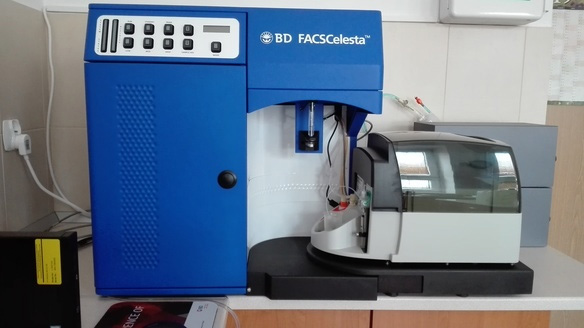
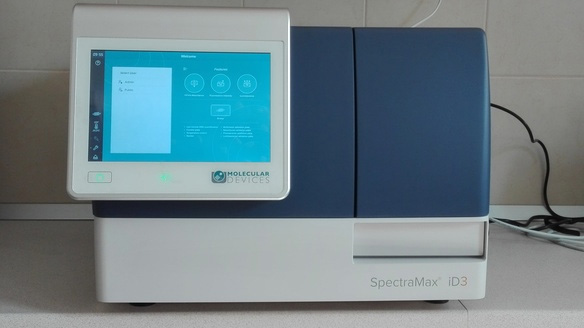
Spectrofluorimeter SpectraMax iD3
Multi-mode microplate reader SpectraMax iD3 (Molecular Devices, San Jose, California, USA) enables measurements of absorbance, fluorescence (from top and bottom), luminescence and kinetic measurements. It is equipped with thermostated reading chamber enabling temperature regulation (from 5 °C above ambient to 66 °C) and plate shaking. It is used for biochemical analyses, immune-enzymatic tests (ELISA), and others.
Automatic cell counter Arthur
Automatic, fluorescence cell counter Arthur (NanoEnTek, Seoul, South Korea) is a 3-channel counter (bright field, green fluorescence, red fluorescence) enabling fast analyses of cell suspension, expression of green and red fluorescence proteins, cell viability, apoptosis and cell cycle in 25 µl sample volume. The counter is compatible with a wide variety of eukaryotic cells.
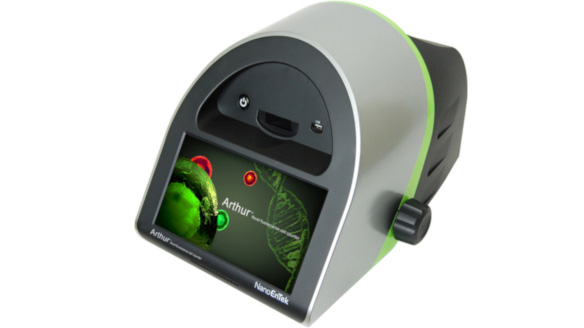
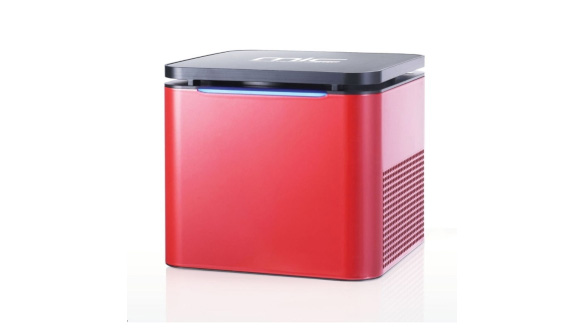
MIC qPCR thermocycler
MIC thermocycler (Bio Molecular Systems, Upper Coomera, Australia) for gene expression analysis by real-time PCR, based on magnetic induction technology, 4-channel model with a rotor for 48 samples ensures constant optical pathway, temperature homogeneity and precision. It enables PCR performing in reaction volume from 10 to 35 µl.
CO2 Incubator MIDI 40
CO2 incubator MIDI 40 (Thermo Scientific, Waltham, Massachusetts, USA) for cell culture, ensures suitable CO2 concentration, air humidity and temperature, with air coat and 40 l, stainless steel working chamber. It is dedicated for short-term lymphocyte cultures (proliferation tests).
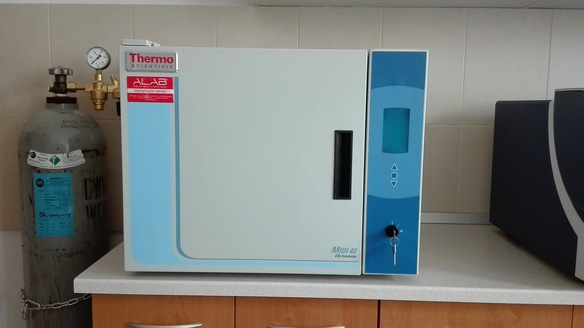
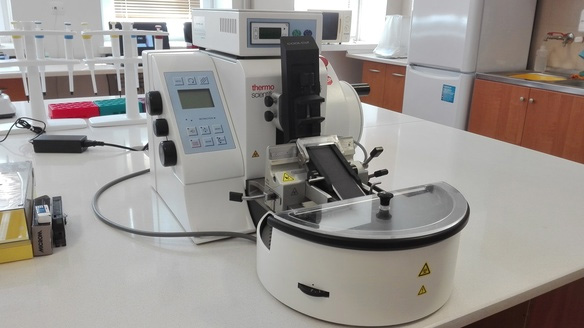
Automatic rotary microtome HM355S
Automatic rotary microtome HM355S (Thermo Shandon Limited, Runcorn, UK) with a section transfer system (STS) on a wet tray and Cool-Cut system for precise cutting of biological material embedded in paraffin blocks. Microtome enables cutting of histological slices of 0.5 to 100 µm thickness. Cool-Cut system keeps for a long time a low temperature of paraffin block in a holder and along with STS ensures maximal elasticity of slices.
Dry air sterilizer/oven FN500
Dry air sterilizer/oven FN500 (Nüve, Ankara, Turkey) of 120 l working capacity, microprocessor controlled, with forced air ventilation ensuring high temperature homogeneity and stability. Temperature range: from +5 °C above ambient to 250 °C. It is used for dry heat sterilization of tools, drying of histological slices and sample incubation during analyses.
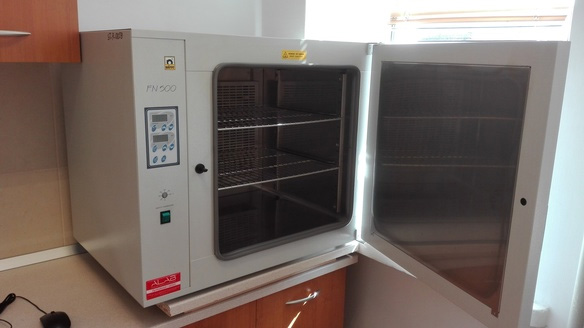
Contact: The Kielanowski Institute of Animal Physiology and Nutrition Polish Academy of Sciences,
Instytucka 3, 05-110 Jabłonna
PhD eng. Marcin Barszcz
🖂 m.barszcz@ifzz.pl; tel. 22 765 33 00; 22 765 33 30


